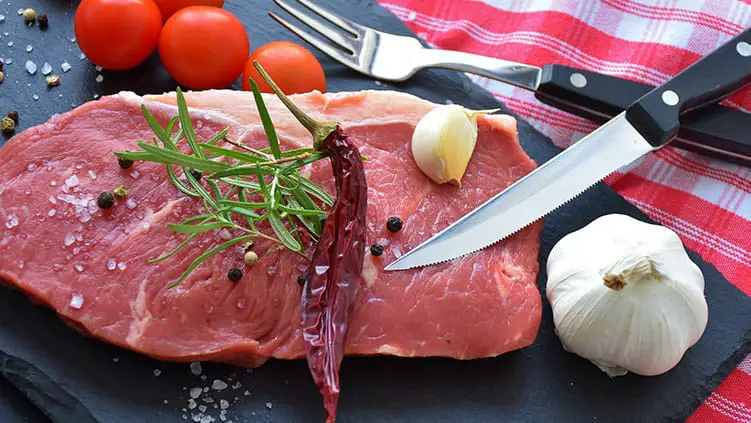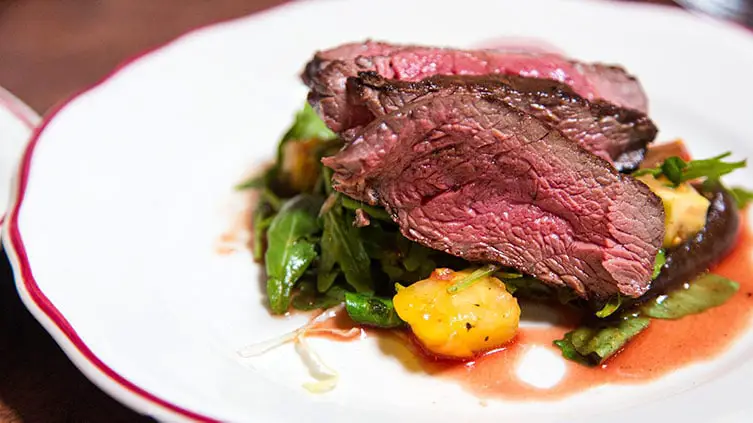There are usually two types of people: those who are convinced that eating raw beef is completely safe and healthy and those who think the opposite. Perhaps you don’t belong to any of those groups. You may just want to know if it’s safe to eat raw beef and what can happen if you decide to try it.
This article is meant to answer exactly these questions. My goal is to give you all the necessary information that you need to have a well-informed opinion. So who is right? Is it safe to eat raw beef? Can it have any undesired consequences?
Let’s see what science says.
Why Do Most People Usually Cook Beef?
Cooking beef (and other foods) have two major benefits. The first one is food safety: a properly cooked beef doesn’t contain any living microbes (including bacteria, viruses, and parasites) because high enough temperatures kill all of them. The second major benefit is that cooking makes beef (and meat in general) easier to digest. Let’s start with the latter.
Humans are omnivores, like our ancestors, the apes. That means we can get energy from both plant and animal matter. However, it’s also true that our stomach has to work harder to digest meat because it contains a lower amount of acidity than the stomach of the carnivores; their digestive juices are simply more effective when it comes to breaking down meat (1).
Cooking makes beef easier to digest because it promotes the breakdown of macromolecules, like proteins. That is to say, cooked beef requires less energy to digest compared to raw beef (2).
Cooking also makes chewing any meat easier. Chewing is considered to be the first step of the digestive process. Poor chewing increases the likelihood of poor digestion and nutrient absorption. According to research, raw meat requires more chews before swallowing (3). This is another way eating cooked meat helps you save energy.
To sum up, we can say that eating cooked beef has a significant energetic advantage over raw beef consumption.
Now, let’s see the other reason most people prefer cooked beef. Heat irreversibly changes the structure of the proteins in microbes making them functionally inactive. So if you cook your beef well, you don’t have to worry about bacteria and other germs because heating any food to a high enough temperature will kill all the microbes. And yes, most people are concerned about germs. But are those worries reasonable? What consequences can eating raw beef have? What are the major concerns?
What Can Happen If You Eat Raw Beef?

Raw and undercooked beef can contain many different kinds of microbes. Most of them are harmless but there are a few that can cause some really serious diseases. Often, the presence of pathogens is a result of some kind of contamination (often feces) that happens during the processing of the beef.
So, infection (mostly, but not exclusively caused by bacteria) is the major concern when it comes to eating raw beef.
The most common potentially harmful bacteria that can be present in raw beef are the following:
- Escherichia coli
- Staphylococcus aureus
- Campylobacter jejuni
- Salmonella
- Listeria monocytogenes
- Enterococcus faecalis
Raw beef sometimes can also contain viruses and parasites.
Let’s see what can possibly happen if you eat tainted raw beef.
In many cases, infections don’t have any substantial symptoms. Pregnant women, small children, older adults, and those with a compromised immune system are much more vulnerable to food poisonings and infections caused by tainted beef. However, sometimes healthy adults can also get serious diseases due to contaminated beef consumption.
Tainted raw beef can cause quite a few kinds of symptoms depending on the pathogen. Typical symptoms include abdominal pain, diarrhea, nausea, vomiting, fever, headaches, and can last up to several days.
If you’re unlucky, you may experience more severe symptoms. An E.Coli strain (O157:H7), for instance, can cause a potentially life-threatening disease called hemolytic uremic syndrome (HUS). It damages red blood cells, platelets, and small blood vessels that can lead to acute kidney failure (4). HUS is more common among children and seniors.
E. Coli O157 infections are usually associated with undercooked or raw tainted ground beef. Infections caused by this strain of E. Coli first appeared in 1982 when there was an outbreak of bloody diarrhea caused by contaminated hamburgers (5).
Listeriosis is another severe disease that’s especially dangerous for pregnant women, seniors, people with weakened immune systems, and newborns. It’s caused by eating raw beef (or any other food) contaminated with the bacteria Listeria. In healthy adults, many infections remain asymptomatic or they have only mild symptoms. However, listeriosis can have really serious consequences in high-risk groups (miscarriage, preterm delivery, confusion, for instance) (6).
Salmonellosis is a well-known and relatively common disease that usually causes diarrhea, vomiting, abdominal pain, and fever. These symptoms usually last a few days and often don’t require any specific treatment. However, in high-risk groups, Salmonella is more likely to cause more severe symptoms. Young children (under the age of 5) are at the highest risk for Salmonellosis (7).
Campylobacteriosis is caused by Campylobacter bacteria and it’s a pretty common disease in the U.S. (according to the CDC it affects more than 1.3 million people every year). Campylobacter lives in the cow’s intestine and it usually contaminates beef during processing. Symptoms include diarrhea, abdominal pain, fever, nausea, and vomiting.
If you experience any of the above-mentioned or other symptoms after eating raw or undercooked beef, always consult with your doctor. If you accidentally ate raw beef, don’t panic. Often, nothing will happen, especially if the beef was prepared carefully. Much depends on the origin of the beef and your immune system. If you feel sick or have any symptoms, seek medical assistance.
Now that we’ve discussed what can possibly happen if you eat tainted raw beef, let’s see what are the chances that the raw beef you consume is contaminated by some harmful microbes.
Have you ever wondered if freezing kills bacteria? Then it’s time to get a reliable answer based on data and science! We’ve collected everything you should know about freezing and food safety in this article.
So, Is It Safe to Eat Raw Beef? What Are the Chances of Buying Contaminated Beef?
We’ve already examined the possible consequences of eating raw beef, and as you can see, it can cause some really serious health issues in certain cases. However, to get a clearer and more complete picture we should also study the proportion of beef contaminated by any harmful pathogen. So, what are your chances of eating tainted raw beef?
Of course, it would be very hard to test all commercially available beef for all pathogens. Fortunately, Consumer Reports has a detailed study in which researchers analyzed 300 raw ground beef samples from 103 stores and tested them for different types of bacteria.
Researchers examined samples of both conventionally and more sustainably raised cattle. They found that a significantly larger proportion of conventional beef contained bacteria compared to sustainably produced beef. More than 80% of conventional beef was contaminated by two or more types of bacteria. It’s about 20% more than in the case of sustainably produced beef (8).
According to the report, about 97 percent of beef comes from conventionally raised cattle that are more prone to infections compared to grass-fed cattle. That’s one of the reasons (besides promoting weight gain) these cattle are regularly given antibiotics. As a result, multi-drug resistant bacteria are pretty common in conventional beef.
The researchers found that conventional raw beef samples were three times as likely to contain multi-drug resistant bacteria than beef coming from grass-fed cattle (18% vs. 6%).
In conclusion, we can say that beef contaminated with potentially harmful bacteria is not uncommon at all. Beef coming from grass-fed cattle seems to be a safer choice, however, there’s still a real chance of infection when it’s consumed without cooking.
At this point, you might wonder how early humans (before the discovery of fire) avoided most food poisonings while they regularly consumed raw meat. Well, first, they only consumed fresh meat of wild animals that had not been given any antibiotics. Also, they never ate any (rapidly) processed meat and they didn’t store it. All these factors helped them to reduce the risk of contamination and foodborne illnesses. Of course, sometimes they got some serious infection but that was part of normal life in those days.
By the way, most carnivores eat meat the same way as our ancestors in their natural environment. However, carnivores have a much higher amount of acids in their stomach so they’re less prone to food-mediated bacterial infections than humans.
What Do Experts Recommend?
Experts suggest you always cook beef to a safe internal temperature, that is 145° F with a three-minute rest time in the case of whole cuts and 160° F without rest time in the case of ground beef (data from USDA). Why is there a difference between whole cuts and ground beef? During the process of grinding, bacteria from the surface of the meat can get inside the ground meat where higher temperatures are needed to kill them.
Keep in mind that experts and authorities do not recommend eating raw or undercooked beef. Those who belong to a high-risk group should definitely avoid consuming any raw meat.
What About Rare Steaks? Is It Safe to Eat?

Rare means you heat beef to an internal temperature of 125 to 130 degrees, so it will be soft with a red center. According to USDA, the minimum internal temperature should be 145° F (with a three-minute rest time) to kill all the bacteria and avoid food poisonings. Therefore, rare steak is not considered to be safe to eat because it may contain harmful pathogens.
Summary
As you can see, eating raw beef is never completely safe. In fact, it’s a risky business. You have a real chance of getting some kind of infection, especially if the beef comes from conventionally raised cattle. While it’s true that you can reduce the risk of infection by using sustainably produced beef and getting it from a reliable butcher, you can’t completely eliminate it. Much depends on the origin of the beef. Of course, it’s unlikely that you’re served contaminated steak tartare in a high-end restaurant but it happens rarely.
Symptoms can vary from very mild to severe. While many cases are asymptomatic, certain pathogens can cause some really serious foodborne illnesses, especially in high-risk groups. So, you’re better off cooking your beef. This is the only sure way you can save all those unpleasant consequences.











